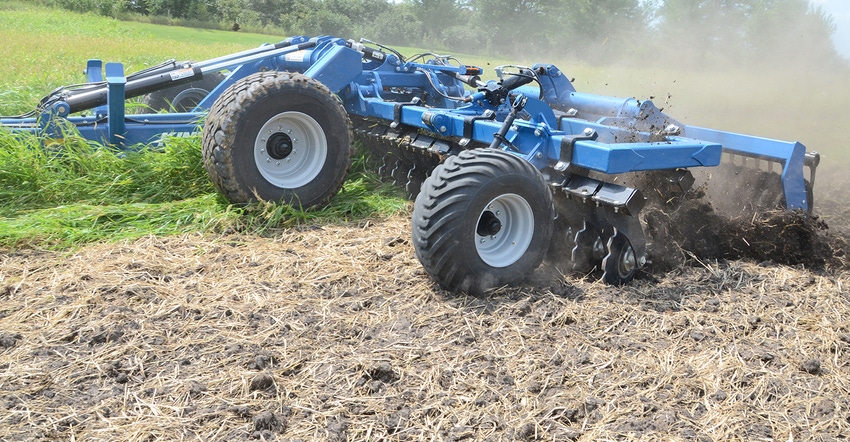August 6, 2018

Entering a new market offers added sales potential for any equipment company, provided the end product is valuable to customers. Kinze’s new relationship with Degelman, announced earlier in 2018, starts with the launch of the Mach Till tool for the 2019 season.
Susanne Kinzenbaw Veatch, president and chief marketing officer, Kinze, shared that the idea of adding to the line through partnerships started with a strategic planning document from January 2017. “We put together a five-year strategic plan and identified nine opportunities,” she said. “The first was in [original equipment] business development, looking at other opportunities to license or manufacture another product for other companies.”
An early opportunity that arose was with Degelman Industries, a privately owned Canadian farm equipment maker that was looking to expand further into the United States.
Veatch noted the company surveys dealers regularly and — a recurring request was for tillage equipment. The connection to Degelman offered that opportunity. Kinze is marketing the Pro Till machine from Degelman as the Mach Till through Kinze dealers. It’s a hybrid machine that brings Kinze dealers into the high-speed tillage market.
This deal offers a win-win for the two private companies. Degelman gets expanded distribution through Kinze dealers; Kinze gets a new product to market and fulfill dealer requests. Both companies noted that the only difference between the two brands is that the Kinze will be blue (and be called a Mach Till).
The hybrid approach
And what is a hybrid tillage machine? “The Mach Till is a hybrid horizontal tillage tool that brings the advantages of conventional disks [and] residue mixing and works like a vertical tillage machine,” said Justin Render, Mach Till product manager. “This machine performs many functions in one pass and provides a good soil finish at high speed.”
This is a machine that performs best above 8 mph. “With Mach Till 605, the residue is mixed into the soil, depending on how deep you run,” Render said. “This returns crop nutrients to the ground without letting them blow away. The 40% that remains on top acts as a mulch layer that’s held in contact with the soil. The erosion control is there.”
A common complaint about some tillage systems is that residues blow off the field into ditches, taking along valuable nutrients. And sometimes the only choice is to burn off that residue, which is a waste for the farm.
Render explained the system from front to back: Each disk is on its own torsion arm that provides even flow through material. Disk arms are set up so there’s 10 inches between each blade. The front “gang” of disk arms are angled 14 degrees, with 4 degrees of tilt; the rear disks are at 17 degrees (in the opposite direction), with 6 degrees of tilt.
The front disks lift and cut material to one direction; the second row of disks hit that material in the opposite direction, creating aggressive mixing. Then, a corrugated rubber roller follows behind to create a smooth finish. This machine works best at a higher speed, and in an artificial field demo did a solid job of cutting and mixing a standing corn crop, a sudangrass-forage crop and a grass hay field.
Speed and horsepower
The system works at higher tillage speeds, but you can also cover a lot of ground in an hour with this machine. The 20-foot Model 201, for example, can cover 30 acres per hour at 12.4 mph. The largest Mach Till, the 40-foot Model 401, gets over 60 acres per hour at that speed. “We’ve had units out for demonstration, and the farmers didn’t want to give them back to us,” Render said.
To get that kind of productivity, Kinze also recommends having adequate horsepower. For the MT 201, the company recommends 350 hp in the fall and 300 hp in the spring; for the MT 261 (26 feet), Kinze recommends 400 hp for the fall and 350 hp for spring; for the MT 331 (33 feet), you need 500 hp in the fall and 450 hp in spring; and for the largest Mach Till, MT 401, 600 hp is recommended in the fall and 550 hp in spring. This assumes you’re operating at about 3 inches deep.
Tillage equipment has to be seen to be believed, and Kinze management knows it. Eric Broadbent, Kinze director of sales, noted that early orders for the first season of Mach Till were ahead of company expectations — and this in a soft equipment market. But to proceed for the future, the company is launching a demonstration program.
“We kicked off the first demonstration event here in Williamsburg [Iowa, where the company’s headquarters are] today,” Broadbent said during a company event recently. “We will have demonstration machines in each sales district. Even though we’re new to the tillage business, we know the best approach to sales is demo, demo and more demos — we have to put them in the field.”
Farmers interested in seeing a Mach Till in action should reach out to their local Kinze dealer. For more information on the Mach Till, visit kinze.com.
About the Author(s)
You May Also Like






